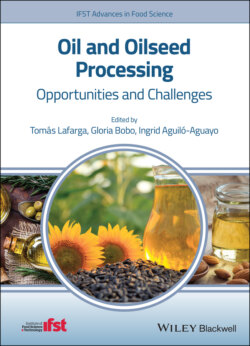Читать книгу Oil and Oilseed Processing - Ingrid Aguilo-Aguayo - Страница 33
2.2.2 Physicochemical Properties of Oilseeds Oils
ОглавлениеRelative density, viscosity, refractive index, smoke point, flash point, fire point, melting point, and crystallization as well as thermal behavior are some of the chemical properties of importance in oilseeds oils to consider for food applications. The crystallization or polymorphisms properties greatly affects the textural and functional properties of oils. Soybean oil tends to form β‐crystals in contrast to the hydrogenated form that can be crystallized in β’, form achieving desired functional properties in the final product (Gunstone 2011). Temperature affects the density of oilseed oils leading to a density decrease with an increment of temperature. Predictions by mathematical model to estimate changes in the viscosity of oils have been developed helping to predict the physical changes (Rodenbush et al. 1999). Table 2.1 shows some of the key physical characteristics of some of the key oilseed oils comparing to a standard olive oil. Refractive index could help to predict oil viscosity and in turn key physical properties (Gunstone 2011). In the case of flash point (Table 2.1), temperatures of the different oilseed oils around 300 °C differ depending at which temperature the volatiles are produced in amounts that ignite but do not appear as a flame (Gunstone 2011). Peroxide values indicate the level of primary oxidation, which could increase when the oils are exposed to light. The food industry frequently adds sources of antioxidants to enhance oil protection from oxidation changes. Carelli et al. (2005) reported the effectiveness of adding ∝‐ and δ‐tocopherol, citric acid, ascorbic acid, and ascorbyl palmitate in sunflower oil observing that ascorbic acid improved the rancimat oxidative stability of the oil. The measure of iodine value is linked to the degree of unsaturation of fat and oil. Therefore, a low iodine value is related to a high level of saturated and MUFA as observed in palm‐based or coconut oils (Table 2.1).
